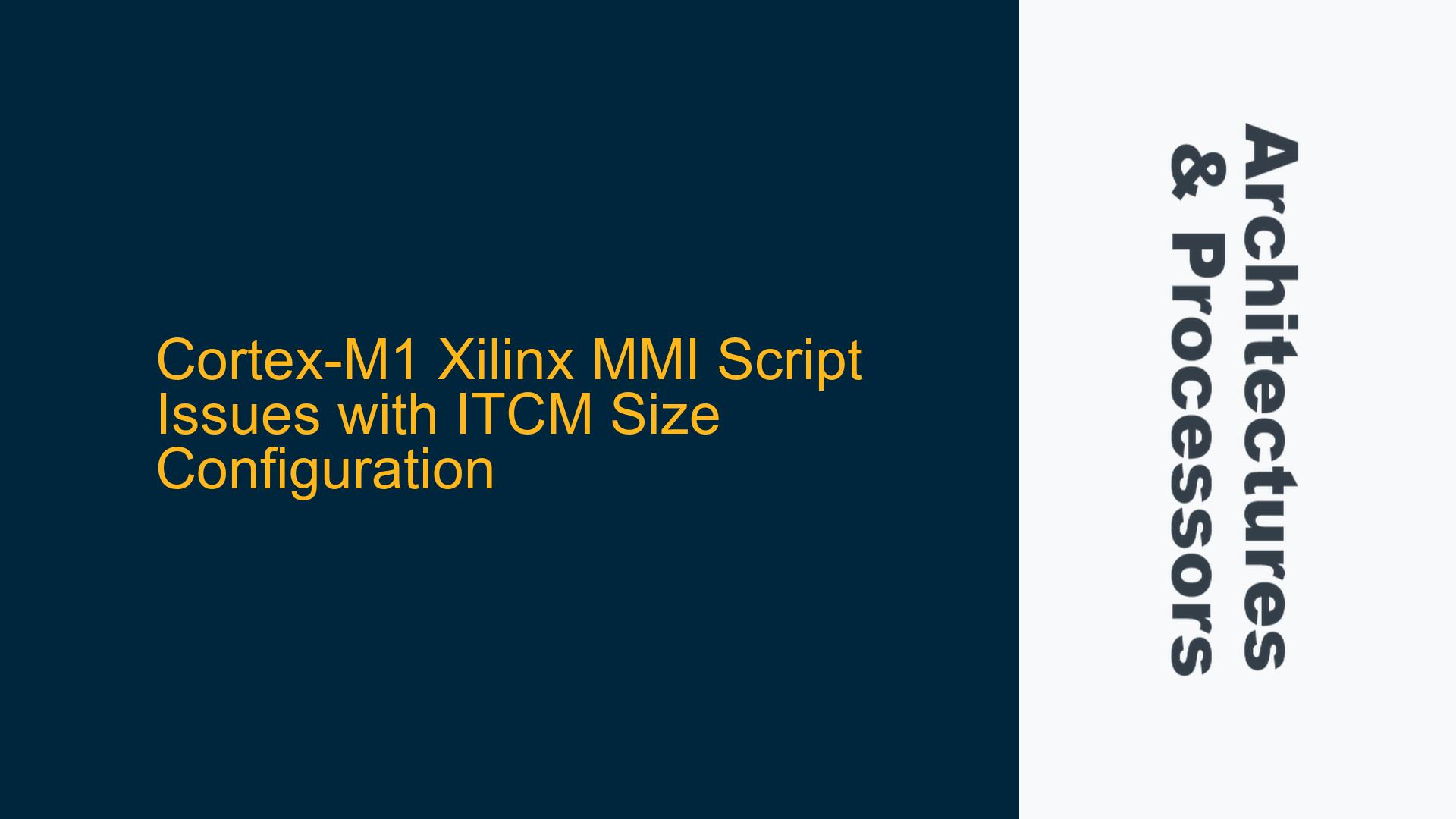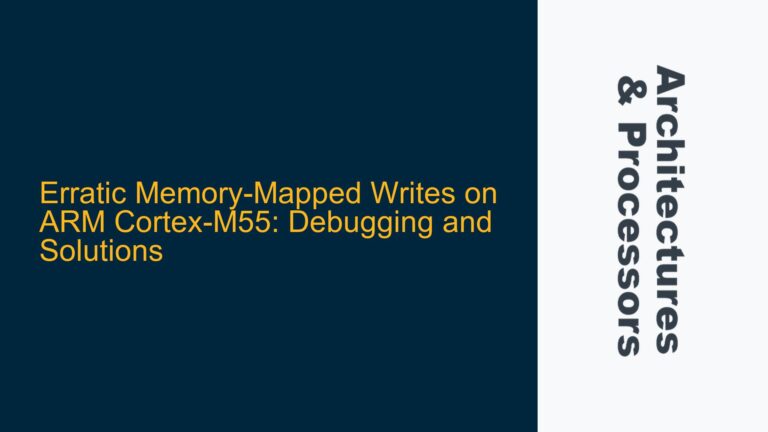ARM Cortex-M1 MMI Script Fails for ITCM Sizes Greater Than 16kB
The core issue revolves around the make_mmi_file.tcl script provided in the ARM Design Start Xilinx pack, which is used to generate Memory Map Information (MMI) files for Cortex-M1 systems implemented on Xilinx FPGAs. The script appears to function correctly for ITCM (Instruction Tightly Coupled Memory) sizes of 16kB or smaller but fails when the ITCM size exceeds 16kB. This failure is particularly evident when the ITCM memory is configured to use cascaded BRAMs (Block RAMs), which occurs for larger memory sizes. The script seems unable to handle the cascaded BRAM configuration, leading to incomplete or incorrect MMI file generation.
The issue is compounded by a potential typo in the script’s conditional logic, which incorrectly checks the ITCM size range. The original line if { ($itcm_size_bytes <= (4*4096)) || ($itcm_size_bytes > (32*4096)) } { should be modified to if { ($itcm_size_bytes < (4*4096)) || ($itcm_size_bytes > (32*4096)) } { to allow the script to proceed when 16kB ITCM is specified. However, even with this correction, the script fails for ITCM sizes greater than 16kB, indicating a deeper issue with how the script handles BRAM cascading.
ITCM BRAM Cascading and Script Logic Limitations
The primary cause of the issue lies in the script’s inability to handle cascaded BRAM configurations, which are required for ITCM sizes greater than 16kB. In Xilinx FPGAs, BRAMs are typically organized in 4kB blocks, and for ITCM sizes larger than 16kB, these blocks must be cascaded to form a contiguous memory space. The make_mmi_file.tcl script appears to be designed for flat BRAM configurations, where each BRAM block is associated with a single byte lane, as is the case with 16kB ITCM. However, when the ITCM size exceeds 16kB, the BRAMs must be cascaded, and the script lacks the necessary logic to generate the correct MMI file for this configuration.
Another contributing factor is the script’s conditional logic, which incorrectly checks the ITCM size range. The original condition if { ($itcm_size_bytes <= (4*4096)) || ($itcm_size_bytes > (32*4096)) } { is flawed because it excludes the 16kB case when the ITCM size is exactly 16kB. This forces users to modify the script to allow 16kB ITCM configurations, but even with this modification, the script fails for larger ITCM sizes due to the cascading issue.
Additionally, the script may not account for the specific BRAM addressing and configuration requirements of the Xilinx Virtex Ultrascale+ devices. The script was originally designed for the 7000 series devices, and while the device and primitive names were updated for the Ultrascale+ series, the underlying logic for handling BRAM cascading may not have been fully adapted. This could result in incorrect MMI file generation, leading to potential issues during FPGA synthesis and implementation.
Modifying the MMI Script for Cascaded BRAMs and Larger ITCM Sizes
To address the issue, the make_mmi_file.tcl script must be modified to handle cascaded BRAM configurations and larger ITCM sizes. The following steps outline the necessary changes and considerations:
-
Correct the Conditional Logic: The first step is to correct the conditional logic in the script to properly handle the 16kB ITCM case. The line
if { ($itcm_size_bytes <= (4*4096)) || ($itcm_size_bytes > (32*4096)) } {should be changed toif { ($itcm_size_bytes < (4*4096)) || ($itcm_size_bytes > (32*4096)) } {. This ensures that the script does not exclude the 16kB ITCM configuration. -
Implement Cascaded BRAM Handling: The script must be updated to handle cascaded BRAM configurations. This involves modifying the script to recognize when BRAMs need to be cascaded and generating the appropriate MMI file entries for these configurations. The script should include logic to calculate the number of cascaded BRAMs required for the specified ITCM size and generate the corresponding memory map entries.
-
Update BRAM Addressing Logic: For larger ITCM sizes, the script must correctly calculate the BRAM addressing to ensure that the cascaded BRAMs form a contiguous memory space. This involves updating the script to account for the increased address range and ensuring that the generated MMI file correctly reflects the memory map.
-
Verify Device-Specific Configuration: The script should be reviewed to ensure that it correctly handles the BRAM configuration for Xilinx Virtex Ultrascale+ devices. This may involve updating the script to use the correct primitive names and addressing schemes specific to the Ultrascale+ series.
-
Test with Various ITCM Sizes: After making the necessary modifications, the script should be tested with various ITCM sizes, including 16kB, 32kB, and larger configurations, to ensure that it correctly generates the MMI file for both flat and cascaded BRAM configurations.
-
Document the Changes: Finally, the changes made to the script should be thoroughly documented, including the rationale for each modification and any potential limitations or considerations. This documentation will be valuable for future users who may need to further modify or adapt the script for different devices or configurations.
By following these steps, the make_mmi_file.tcl script can be updated to handle larger ITCM sizes and cascaded BRAM configurations, ensuring that it generates correct and reliable MMI files for Cortex-M1 systems implemented on Xilinx FPGAs. This will enable users to take full advantage of the available memory resources and avoid potential issues during FPGA synthesis and implementation.
Detailed Explanation of Script Modifications
Correcting the Conditional Logic
The original conditional logic in the script is designed to check whether the ITCM size falls within the valid range of 4kB to 32kB. However, the condition if { ($itcm_size_bytes <= (4*4096)) || ($itcm_size_bytes > (32*4096)) } { incorrectly excludes the 16kB case when the ITCM size is exactly 16kB. This is because the condition uses <= for the lower bound, which means that an ITCM size of exactly 16kB (4*4096 bytes) will trigger the condition and cause the script to fail.
To fix this, the condition should be modified to use < for the lower bound, as follows: if { ($itcm_size_bytes < (4*4096)) || ($itcm_size_bytes > (32*4096)) } {. This ensures that the script does not exclude the 16kB ITCM configuration and allows the script to proceed when 16kB ITCM is specified.
Implementing Cascaded BRAM Handling
For ITCM sizes greater than 16kB, the BRAMs must be cascaded to form a contiguous memory space. The original script is designed to handle flat BRAM configurations, where each BRAM block is associated with a single byte lane. However, when the ITCM size exceeds 16kB, the BRAMs must be cascaded, and the script lacks the necessary logic to generate the correct MMI file for this configuration.
To implement cascaded BRAM handling, the script must be updated to recognize when BRAMs need to be cascaded and generate the appropriate MMI file entries for these configurations. This involves adding logic to calculate the number of cascaded BRAMs required for the specified ITCM size and generating the corresponding memory map entries.
For example, if the ITCM size is 32kB, the script should recognize that 8 BRAM blocks (each 4kB) are required and that these blocks must be cascaded to form a contiguous 32kB memory space. The script should then generate the appropriate MMI file entries to reflect this configuration.
Updating BRAM Addressing Logic
For larger ITCM sizes, the script must correctly calculate the BRAM addressing to ensure that the cascaded BRAMs form a contiguous memory space. This involves updating the script to account for the increased address range and ensuring that the generated MMI file correctly reflects the memory map.
The script should include logic to calculate the base address for each cascaded BRAM block and ensure that the addresses are contiguous. For example, if the ITCM size is 32kB, the script should calculate the base addresses for each of the 8 BRAM blocks and ensure that they are contiguous, starting from the base address of the ITCM memory region.
Verifying Device-Specific Configuration
The script should be reviewed to ensure that it correctly handles the BRAM configuration for Xilinx Virtex Ultrascale+ devices. This may involve updating the script to use the correct primitive names and addressing schemes specific to the Ultrascale+ series.
For example, the script may need to be updated to use the correct BRAM primitive names for the Ultrascale+ series, as these may differ from the 7000 series devices. Additionally, the script should be reviewed to ensure that it correctly handles the addressing schemes for the Ultrascale+ series, as these may also differ from the 7000 series devices.
Testing with Various ITCM Sizes
After making the necessary modifications, the script should be tested with various ITCM sizes, including 16kB, 32kB, and larger configurations, to ensure that it correctly generates the MMI file for both flat and cascaded BRAM configurations.
For example, the script should be tested with an ITCM size of 16kB to ensure that it correctly generates the MMI file for a flat BRAM configuration. The script should also be tested with an ITCM size of 32kB to ensure that it correctly generates the MMI file for a cascaded BRAM configuration.
Documenting the Changes
Finally, the changes made to the script should be thoroughly documented, including the rationale for each modification and any potential limitations or considerations. This documentation will be valuable for future users who may need to further modify or adapt the script for different devices or configurations.
For example, the documentation should include a description of the changes made to the conditional logic, the implementation of cascaded BRAM handling, the updates to the BRAM addressing logic, and the verification of device-specific configuration. The documentation should also include any limitations or considerations, such as the maximum ITCM size that the script can handle or any known issues with specific device configurations.
Conclusion
The make_mmi_file.tcl script provided in the ARM Design Start Xilinx pack is a critical tool for generating MMI files for Cortex-M1 systems implemented on Xilinx FPGAs. However, the script has limitations when it comes to handling larger ITCM sizes and cascaded BRAM configurations. By correcting the conditional logic, implementing cascaded BRAM handling, updating the BRAM addressing logic, verifying device-specific configuration, testing with various ITCM sizes, and documenting the changes, the script can be updated to handle larger ITCM sizes and cascaded BRAM configurations, ensuring that it generates correct and reliable MMI files for Cortex-M1 systems implemented on Xilinx FPGAs. This will enable users to take full advantage of the available memory resources and avoid potential issues during FPGA synthesis and implementation.






